


Framed or unframed, desk size to sofa size, printed by us in Arizona and Alabama since 2007. Explore now.
Shorpy is funded by you. Patreon contributors get an ad-free experience.
Learn more.

- Details, Details
- What's that building to the left of the tower?
- Coal Barges
- Bromo-Seltzer
- Inner harbor
- The Basin
- What a headache!
- Giant stepladder?
- Baldwin 62303
- Baldwin VO-1000
- Cold
- No expense spared
- Tough Guys
- Lost in Toyland
- And without gloves
- If I were a blindfolded time traveler
- Smoke Consumer Also Cooks
- Oh that stove!
- Possibly still there?
- What?!?
- $100 Reward
- Freeze Frame
- Texas Flyer wanted
- Just a Year Too Soon
- WWII -- Replacing men with women at the railroad crossing.
- Yes, Icing
- You kids drive me nuts!
- NOT An Easy Job
- I wonder
- Just add window boxes
Print Emporium
Manhasset 346: 1942
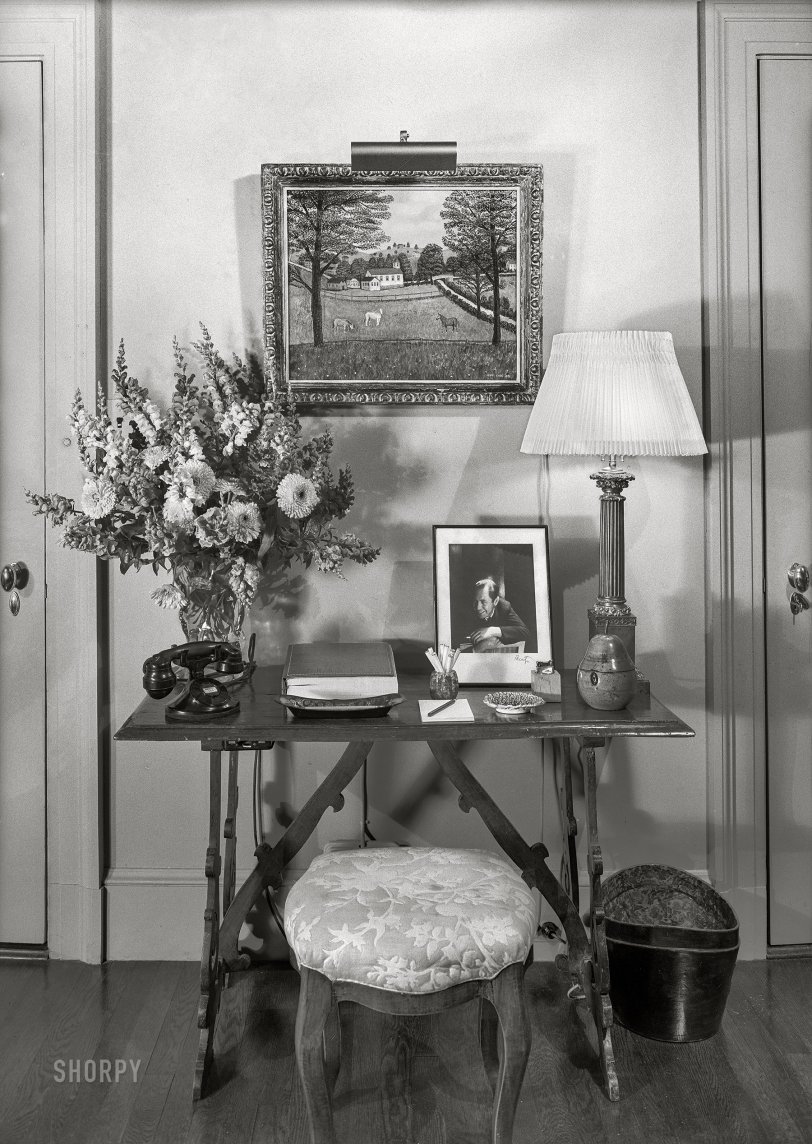
May 12, 1942. "William S. Paley, residence in Manhasset, Long Island, New York. Library, telephone table." 5x7 acetate negative by Gottscho-Schleisner. View full size.
Paley by Beaton
That is indeed Paley in a portrait by Cecil Beaton.
Tea (or tobacco) caddy at the ready
The 18th-century, pear-shaped tea caddy on the right was probably used in Paley's time to hold tobacco, according to the "Antiques Roadshow" I happened to see last night. It had a lock to keep the servants from poaching the precious tea.
Private Telephone Line
I believe that Manhasset 346 was a private line. Most phones in manual systems were on party lines in those days, and depending on the system you would see numbers like Leamington 22-X, or Richmond 15-R-12. The ring code for the operator at the Richmond number would be 1 long followed by 2 short rings. A private phone number without letters was often for a business, a doctor or the Paleys.
Facing the music (stand)
As a musician, when I saw the name Manhasset, I immediately thought of the iconic black metal music stands made by a company of the same name. But (as the young'uns would say), I was "today years old" when I found out that Manhasset was also the name of a town.
(And yes, the company that manufactures the stands originated in this town, though it relocated to Washington state in the early '40s.)
Portrait by Cecil Beaton?
I haven't found the image online yet but it looks to me like Cecil Beaton's signature on that portrait of William S Paley. Ironically enough as Beaton's pre-WW2 career in the US was interrupted by accusations of anti-Semitism: "In 1938, he inserted some tiny-but-still-legible anti-Semitic phrases (including the word "kike") into American Vogue at the side of an illustration about New York society. The issue was recalled and reprinted, and Beaton was fired" (Wikipedia).
Same Photo
I believe this is same photo as seen (partially obscured) earlier in the living room.
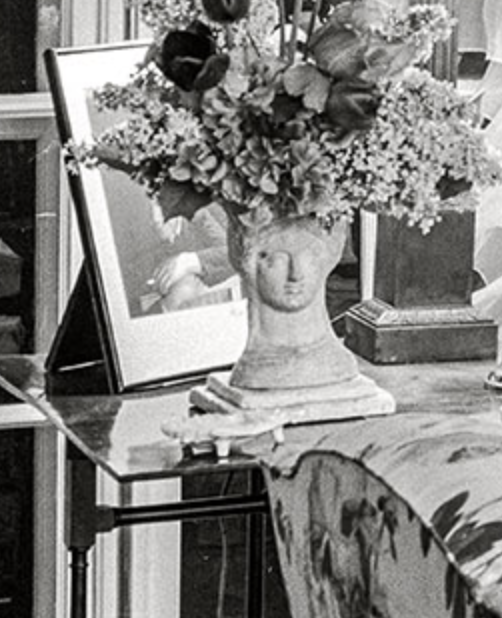
Wandering eye and portrait
Someone in the household must have liked that particular portrait of Paley; you can also see it in the living room on the glass table next to the sofa. If that was Mrs. Paley's way of "keeping an eye on" her husband, it predictably failed.
Smokes and Phones
I was never a heavy smoker and I quit over thirty years ago, but I always had to light one up while talking on the phone. It was a ritual in my house that we smoke after meals too, even after breakfast.
Paley in the Framed Pic?
Can anyone tell if that's Paley in the framed photograph? I attach the Wikipedia pic of him to this comment.
And a bit of Long Island anti-Semitism history from Wikipedia: "Paley married divorcée, socialite and fashion icon Barbara "Babe" Cushing Mortimer (1915–1978) on July 28, 1947. She was the daughter of renowned neurosurgeon Harvey Cushing. William and Babe Paley, in spite of their successes and social standing, were barred from being members of country clubs on Long Island because he was Jewish."
https://en.wikipedia.org/wiki/William_S._Paley
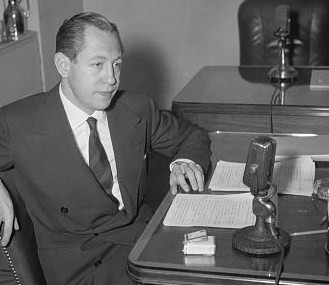
How quaint!
A whole table devoted to an appliance that has for many people today become a digital (in both senses) appendage.
Tobacco sponsors
For all the cigarettes that were advertised on CBS, no doubt Paley had regular samples from the tobacco companies, gratis.
You Can Ring...
but you can't hide. The older 202 sets did not have bells in the phone itself. There was a ringer box attached to the phone that would ring. This ringer box is attached to the underside of the table. They were very loud, and this table would only amplify the sound. You could probably hear this one across the street.
John Kane: a Shorpian Life
Kane's father died when he was age 10, and young John quit school to work in the shale mines. He mined coal in Alabama, Tennessee, and Kentucky. He worked on the railroad, first as a gandy dancer (stamping down stones between the railroad ties) until he lost a leg when struck down by an engine running without its lights. Later, he painted trains and houses.
Kane attracted attention from the media when his paintings were first admitted to the 1927 Carnegie International Exhibition. His success was suspected to be a prank. Today, his paintings hang in major museums, including the Museum of Modern Art. My two cents: his most interesting paintings are cityscapes of industrial Pittsburgh.
Kane's life story was told in "Sky Hooks: The Autobiography of John Kane," written with Marie McSwigan.
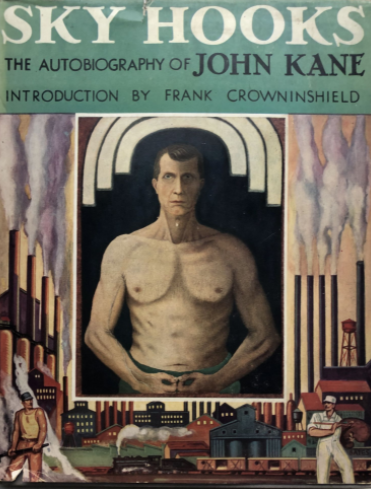
Farm Scene With Three Horses (1931)
John Kane (1860–1934)
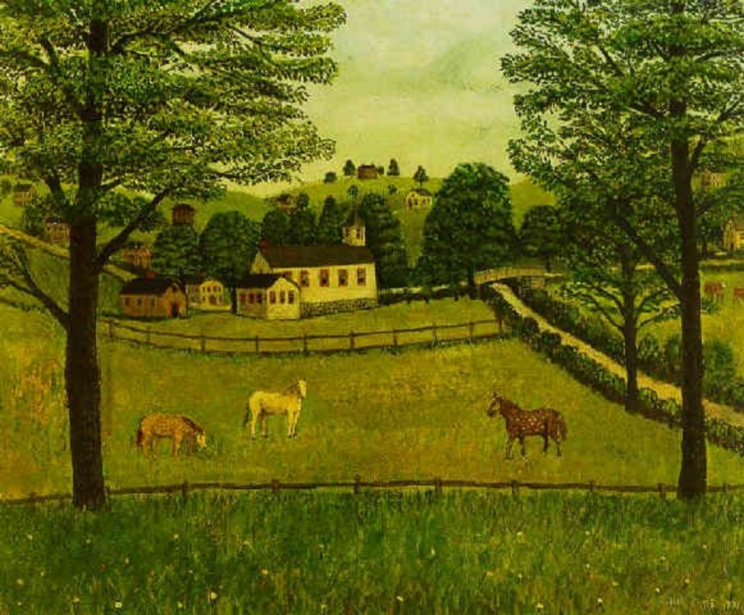
Holy smokes!
Did this man own stock in a tobacco company? Cigarettes have been in pretty much every image of this guy's house. Yes, I am aware that a lot of folks smoked back then. (My grandfather was a three packs a day man who also liked his pipe.) But I've never seen a house where cigarettes were part of the ambiance and décor.
























On Shorpy:
Today’s Top 5